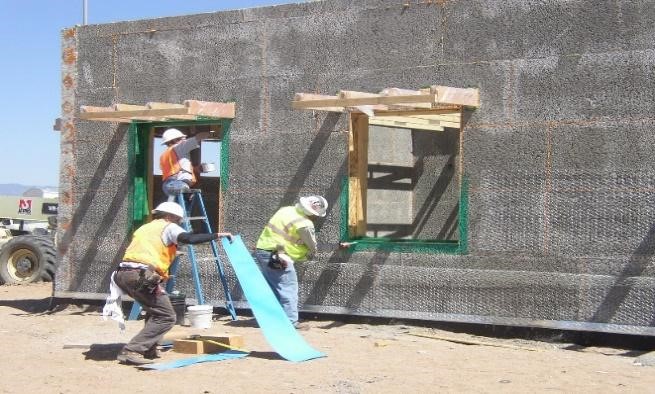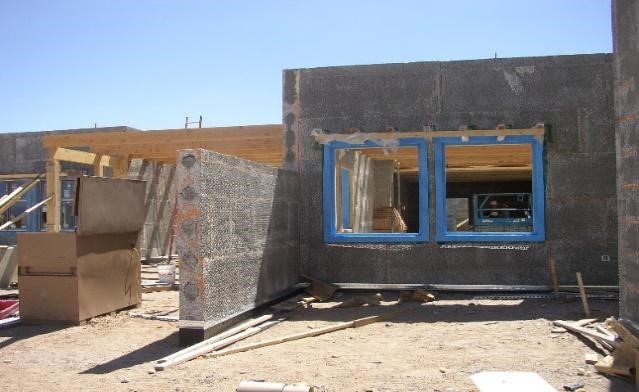WATER PROOFING
Above Grade
RASTRA INC products do not wick water, rather it drains and can be left without finish for extended time. It is not water tight.
Once stucco is applied care has to be taken that water does not seep into the wall where it could get trapped and accumulates until it has to find a way out. Stucco systems shall be recognized by codes and applied in accordance to the manufacturer’s specification and code official’s satisfaction. Recommended are Portland cement stucco systems with content of fibrous material, such as Ultrakote Products, Kwik Kote Corp., Sacramento Stucco Western 1- Kote, or the like. If a top coat is to be applied, preferably elastomeric (PU or acrylic based) products are being used.
Begin the process by removing loose debris, dust and any protrusions from the wall surface. Dampen the surface before applying any mortar – this helps prevent the wall from pulling moisture out of the stucco too quickly, which could cause cracking and loss of bond. Coatings can be applied in one, two or three layers.
If applying a two coat system, the base coat is the leveling coat with the second serving as the finish coat. In this case the base coat is approximately 1/4″ or as required to create a level coat. The final coat is 1/8″ or as needed for a uniform finish.
If using a three coat system. The first layer is normally 1/8″ to 3/8″ thick and is referred to as a “scratch” layer because once applied, the surface is ‘scratched’ to provide a more receptive surface for the second layer. The second layer is usually applied 1/8″ to 3/8″ thick. This coat is sometimes referred to as a “floating” or “brown” coat. The third or final layer is typically 1/8″ or less thick and often colored and/or textured.
Allow the first layer to harden for 24 to 36 hours. Do not let this layer dry out, if necessary, keep it damp by misting it with water, do not spray it with a pressure hose as it will dislodge the mortar.
After the stucco installation is complete, keep the stucco damp over several days; lightly mist the surface occasionally if necessary. Allow mortar to dry for at least six weeks before applying cement paint or color wash
Complete the job by sealing around doors and window frames – these areas are especially susceptible to water penetration. This step is extremely important, intrusion of water into the Rastra wall has to be avoided. Particularly check all horizontal areas, like parapets and window sills. The proper way the seal is the following:


Two photos of proper window sealing Prime first (green is primer) then apply (blue) self-adhesive membrane. Order of membrane application is critical:
- Window Sill first
- Window jambs second
- Headers third
Product recommendation:
Henry Blue Skin SA Membrane and Henry Aqua Tac 545 Primer, Loxon primer by Sherwin Williams, or Seal Krete sealer. Be careful to follow all product instructions for any sealant you choose. Carefully follow application instructions of any sealant product you choose. Caulking gaps around windows, doors, or headers etc. shall be of adequate size in order to have sufficient caulking material to bridge any difference in expansion of the stucco and other materials.
In critical cases consider using a damp-proof layer between slab and the Rastra wall to block moisture rising from the foundation. Also, you may consider providing some possibility of moisture drainage such as a French drain. As well as installing the Rastra wall protruding for approximately ½” over the slab. Water getting caught in a Rastra wall (or as in any wall; wood or masonry) which is sealed with stucco with nowhere to go, may lead to wet spots, discoloration and damage.
Below Grade
RASTRA INC walls installed below grade must be treated with a layer of protective sup grade waterproofing in accordance with Section 1806 of IBC. Any type of code approved system can be used (solvent containing products are no problem as only few EPS particles on the surface of the Rastra wall will be affected). Roll on, spray on, and then applying the membrane, protect the sealant as backfilling begins. In addition to the membrane one can also install a thin (1/2”) EPS sheet covering the sub grade.
